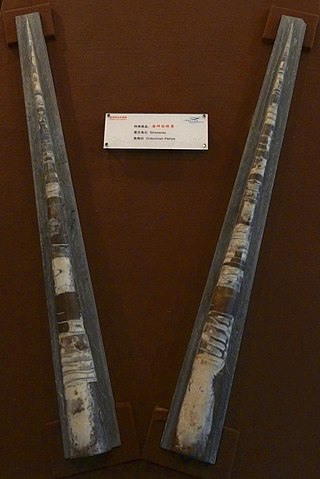Related Research Articles
Acanthonautilus is an extinct genus in the nautilid family Solenochildae (Aipocerataceae) from the Upper Mississippian of North America and equivalent strata in Europe, first described by Foord in 1896.
Uranoceras is a barrandeocerid genus from the Middle Silurian belonging to the family Uranoceratidae, characterized by its loosely coiled, gyroconic shell of 1.5 to 2 subquadrate whorls.
Homaloceras is an extinct nautiloid cephalopod from the Middle Devonian with a strongly curved shell, included in the nautilid family Centroceratidae.
Franklinoceras is an extinct gensu of cephalopods from the nautiloid order, Discosorida. Nautiloids comprise a subclass of shelled cephalopods that were once diverse and numerous but are now represented by only a handful of species.
Osbornoceras is a genus of Lower Silurian cyrtoconic nautiloid cephalopods known from Ohio and possibly Manitoba, one of five general currently included in the oncocerid family Karoceratidae.
The Genus Hemichoanella is a small, extinct, orthoconic nautiloid cephalopod from the Lower Ordovician of Western Australia assigned to the orthoceratoid family, Baltoceratidae. Hemichoanella and the Baltoceratidae are part of the subclass of once diverse and numerous shelled cephalopods known as the Nautiloidea.
Ankyloceras is a genus of Early Devonian cephalopods included in the oncocerid family Karoceratidae. The type species, Ankyloceras nesnayamiense named by Zhuravleva, 1974, comes from Nova Zemlya in Russia. Other species have been found in Japan, Morocco, and Russia.
Pancornus is an extinct genus from the nautiloid order Discosorida that lived during the Late Devonian. Pancornus was named by F.A. Zhuravleva in 1972, and is contemporary with other late discosorids such as Parevlanoceras and Raphanites.
Neocycloceras is an extinct genus of nautiloid included in the Pseudorthocerida that lived during the Late Devonian and Mississippian. Neoclycloceras is characterized by a slender, generally circular shell with slightly oblique, sinuous surficial annulations. Its sutures have dorsal and ventral saddles and lateral lobes and become more oblique with age. Saddles point forward, lobes to the rear. Dorsal saddles are broad and low but the ventral ones are high and conspicuous. The siphuncle is located between the center and venter and is nummuloidal, composed of rounded expanded segments, the inside of which contains a continuous laminar lining that is thickest in the middle of the segments and thinnest at the septal necks. Neocycloceras has been found in Pennsylvania in North America and in Morocco in north Africa.
Antigyroceras is a genus of nautiloids in the order Discosorida, known from central Asia, that lived during Late Silurian and Early Devonian times. It is contemporary with the discosorid Endoplectoceras.
Winnipegoceras is an extinct nautiloid genus from the Ordovician belonging to the Order Discosorida.

Sinoceras is an extinct genus of nautiloids from China included in the family Orthoceratidae that lived from the middle Ordovician until the Devonian. The type species, S. chinense, was originally described as "Orthoceras chinense," but then was promoted by Shimizu and Obata to its own genus, Sinoceras, in 1935.
Wardoceras is an extinct nautiloid genus from the late Early Ordovician of Western Utah, assigned to the orthocerid family, Michelinoceratidae
Westonoceras is an extinct nautiloid genus from the Discosorida that lived during the Middle and Late Ordovician that has been found in North America, Greenland, and Northern Europe. It is the type genus for the Westonoceratidae
Arionoceras is an extinct orthocerid genus from the Middle and Upper Silurian, of Europe that is estimated to have lived from 422.9 to 418.1 mya, existing for approximately 4.8 million years.
Bogoslovskya is an extinct orthoceroid cephalopod genus that lived in what is now Asia from the Devonian to the Permian.
Parasphaerorthoceras is an extinct orthocerid genus, a nautiloid cephalopod, that lived in what would be Europe and north Africa during the Silurian from 422.9 to 418.1 mya, having existed for approximately 4.8 million years.
Landeroceras is a genus of straight shelled cyrtogomphoceratid from the Middle Ordovician Big Horn dolomite of Wyoming.
Discosoridae comprise a family of endogastric discosorids, with endocones in the siphuncle, ranging from the Middle Silurian to Middle Devonian.
Manjoceras is a genus of discosorids named by Zhuravleva, 1972; a kind of nautiloid in which the connecting rings of the siphuncle are longitudinally zoned and clasp around the rim of the septal openings.
References
- Selenoceras -Paleodb
- Selenoceras Ubio
- Sepkoski- Cephalopoda Sepkoski, J.J. Jr. 2002. A compendium of fossil marine animal genera. D.J. Jablonski & M.L. Foote (eds.). Bulletins of American Paleontology363: 1–560.